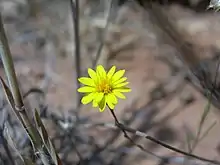| Pentachaeta aurea | |
|---|---|
 | |
| Pentachaeta aurea subsp. aurea | |
| Scientific classification | |
| Kingdom: | Plantae |
| Clade: | Tracheophytes |
| Clade: | Angiosperms |
| Clade: | Eudicots |
| Clade: | Asterids |
| Order: | Asterales |
| Family: | Asteraceae |
| Genus: | Pentachaeta |
| Species: | P. aurea |
| Binomial name | |
| Pentachaeta aurea | |
| Synonyms | |
|
Chaetopappa aurea | |
Pentachaeta aurea is a species of flowering plant in the aster family known by the common names golden-rayed pentachaeta,[2] golden chaetopappa,[3] and golden leastdaisy.[1] It is native to southern California, where it grows in the San Gabriel and San Bernardino Mountains and the Peninsular Ranges, and northern Baja California. It is an annual herb with a hairy stem reaching a maximum height near 36 centimeters from a slender taproot. The narrow linear leaves are up to 5 centimeters long but only a few millimeters wide and may be very hairy. The inflorescence is a solitary flower head, with up to 22 heads per plant. The flower head bears many yellow, brownish, or whitish ray florets 3 to 12 millimeters long, and has a center of many five-lobed yellow to reddish disc florets. The fruit is an achene tipped with a pappus of bristles.
References
- 1 2 Pentachaeta aurea. NatureServe. 2012.
- ↑ Pentachaeta aurea. The Jepson Manual.
- ↑ Pentachaeta aurea. USDA Plants Profile.
External links
- Calflora Database: Pentachaeta aurea (Golden chaetopappa, Golden rayed pentachaeta)
- UC CalPhotos gallery for Pentachaeta aurea .
